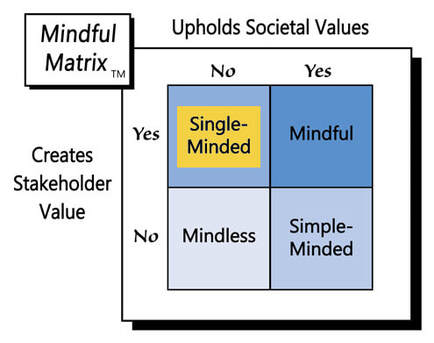author of Honorable Influence - founder of Mindful Marketing
Deception has been part of human history since the serpent misled Adam and Eve. Over millennia, certain marketers have misguided consumers, whether they were ancient merchants using rigged weights and measures, snake oil salesmen pawning impotent elixirs, or auto dealers turning back odometers.
In recent years, the growth of social media and advances in digital technology have helped deception proliferate like never before, both in volume and sophistication. Most of us are all too familiar with fake news, clickbait, and other forms of deceptive communication that cross our paths dozens of times a day.
The two LinkedIn invitations from imaginary people I mentioned above are cases in point; I’ve received many more, as others reading this piece probably have also. Some telltale signs of the fakes are the model-worthy headshots, scarce background info, few existing contacts, and no recent posts.
These forgeries are fairly easy to spot, but others can be much more challenging. Really good photoshopping can be completely undetectable. Although someone occasionally sees and points out part of an image that was secretly altered, such as a celebrity’s unusual narrow waistline, these detected cases are only a fraction of those in which pictures are materially changed and which sometimes deceives others.
As a user of graphic design software since the mid-90s, I know these techniques firsthand. One of my earliest photoshops involved our family’s promotional products business, which was based in a century-old Victorian house. Unfortunately, a large telephone pole with wires projecting in four different directions made it impossible to get a clean picture of the building, so I used Photoshop’s clone stamp tool to make the pole and wires magically disappear.
While digital manipulations of static images have some potential to portray alternate realities, they pale in comparison to what deepfake video can do. Driven by “deep learning,” a form of artificial intelligence (AI), and using face-swapping autoencoders, these extremely realistic videos can make their subjects seem to say and do things they’ve never done or said, which might be completely out of their character.
Most of us have seen lifelike deepfakes, which are easy to find on the web, but the most eerily realistic ones likely have been created by the Belgian company Metaphysic, whose viral videos employing American actor Miles Fisher to deepfake Tom Cruise were highlighted in an illuminating NBC Today segment about the technology.
In the segment, NBC reporter Jacob Soboroff asks Fisher about the ethics of deepfake video and whether it could be a threat to democracy. Fisher replies that the technology is “morally neutral,” adding, “as it develops, the positive output will so far outweigh the negative nefarious uses.”
Fisher’s response is reassuring, but how believable is it given that he does deepfakes to advance his career, and he has a business relationship with a firm that’s monetizing the trend?
As Business Insider has reported, others are also rightly questioning the potential repercussions of deepfakes:
“Many experts believe that, in the future, deepfakes will become far more sophisticated as technology further develops and might introduce more serious threats to the public, relating to election interference, political tension, and additional criminal activity.”
A recent New York Times article shared similar social and political concerns about deepfakes specific to their unsettling spread on TikTok. Times reporter Tiffany Hsu also suggested another very important reason for pumping the brakes on deepfakes:
“But more than any single post, the danger of manipulated media lies in the way it risks further damaging the ability of many social media users to depend on concepts like truth and proof.”
It sounds cliché, but honesty is a foundation of every strong relationship and of every highly functioning society. Productive interactions become impossible when people are unsure who’s lying and who’s telling the truth.
While it’s true that any individual can potentially get ahead by lying, no one gets ahead if everyone lies. As purveyors of what might be the world’s most pervasive communication, marketers should understand the magnitude of their influence and be resolute guardians of truth, for their own livelihoods as well as for the preservation of society.
Here are three ways marketing should fight falsity:
1. Ensure no harm: Not all digitally altered content is created equal. Some is much more likely to significantly change people’s beliefs and actions, often in undesirable ways, while other tactics are more benign. My analysis is biased, but I would put my telephone pole removal example in the harmless category. It’s doubtful that anyone saw the building photo without the wires and developed a significantly different impression of the business.
2. Reveal the truth: If there’s a compelling reason to alter reality, let people know what’s been done. In cases like the Tom Cruise deepfakes that are so good they fool most people, there should be clear disclaimers, e.g., “This is a deepfake.” In other instances, the unrealistic or playful nature of the altered content is enough of a signal. For instance, this past July I wrote an article titled “Cultures of Corruption” for which I photoshopped a winking/smiling Ben Franklin on the front of a $100 bill. It’s doubtful that anyone believed the comical counterfeit.
3. Avoid a deception arms race: Unfortunately, marketing often involves one-upmanship, e.g., if one advertiser employs sexually provocative content that’s effective in attracting attention, other advertisers will insert even more explicit elements in their ads. Meanwhile consumers’ thresholds of tolerance get pushed higher and higher. There’s a real danger of the same kind of advance occurring with deepfakes unless firms follow the previous two prescriptions and refrain from pushing the envelope on realism past the point of easy recognition.
Fortunately, I’m still able to tell when a LinkedIn invitation is a fake. Regrettably, I shouldn’t have to. Organizations that resort to any form of deception in order to change people’s beliefs or cause them to take actions they wouldn’t otherwise choose are truly practicing “Single-Minded Marketing.”
Learn more about the Mindful Matrix.
Check out Mindful Marketing Ads and Vote your Mind!




 RSS Feed
RSS Feed